
7-3-2003
by Trevor Hofmann
Is This a Future Mercury?
In an auto show filled to the brim with more concepts and new model releases than ever before, the Messenger almost faded into Ford's white display stand background. If it was red, lime green or yellow, or some alternatively dramatic hue, maybe it would have stood out more. But then again it wouldn't have looked nearly as pretty.
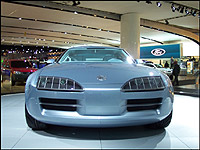 |
| Immediately upon seeing the gorgeous Mercury Messenger at the North American International Auto Show in January I fell head over heals. (Photo: Trevor Hofmann, Canadian Auto Press) |
And look at it, Mercury's Messenger is gorgeous. But that's how impressive last January's North American International Auto Show was. Even a car this impressive got lost in the mix.
Immediately upon seeing it I fell head over heals. I walked around it over and over, only one of a scant number of journalists that seemed minutely interested, snapping shots and contemplating its clean, understated lines. It didn't take too many minutes to figure out what it is about this concept that pulled so heavily on my heartstrings, but ironically the answer has nothing to do with any ties to the Mercury brand. Sure I owned a particularly cool '64 Montcalm coupe, black with red interior and chrome everywhere. What a sled. Mercs were special back then.
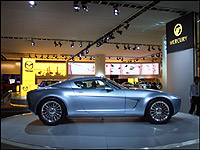 |
| From almost every angle the Messenger expresses the general shape of the '60s Corvette coupe. (Photo: Trevor Hofmann, Canadian Auto Press) |
While at least as impressive, the Messenger looks closer to another car from that era made by its arch rival, Chevrolet. From almost every angle it expresses the general shape of the '60s Corvette coupe, at least to my eyes. Sure the head and taillights differ, although those on the front look a little too close to the fixed headlights used in racing spec Corvettes. Its profile, especially above the shoulder line, stirs up even stronger 'Vette emotions. What's more, I used to cruise with a good friend in his 1964 Corvette coupe, painted an almost identical color of silver blue metallic.
While there will no doubt be a few Corvette aficionados who wished the Messenger was a concept showing the direction the bowtie group might be taking the next generation Corvette, it's not to be. The new concept is all Mercury, and supposedly speaks volumes about that brand's future DNA.
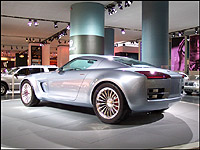 |
| Although styling cues from the Corvette Stingray can be seen, the DNA of the Messenger is all Mercury. (Photo: Trevor Hofmann, Canadian Auto Press) |
In case you're wondering why I chose to use the shortened form for deoxyribonucleic acid (DNA) when describing automotive branding, it wasn't initially my idea. Mercury, like almost every other manufacturer this year, can't stop uttering the catchy term. Personally I'm sick of DNA (not literally) and purposely haven't used it in any reviews up to this date. You've obviously caught me at a weak moment.
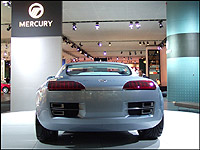 |
| The Messenger conveys Mercury's heritage with sequential taillights. (Photo: Trevor Hofmann, Canadian Auto Press) |
To both show Mercury's commitment to follow this concept's styling trend into future products I'll quote directly from the brand's press material; "The Messenger concept car represents the first expression of Mercury's new design DNA with a clean, technical appearance that begins to establish the look of Mercury products still to come. Mercury will introduce four new products over the next four years including a minivan, a small sport utility and two cars."
Here's Mercury explaining a few styling points, "One aspect of Mercury's future design DNA is embodied by the stacked element theme at the front of the vehicle with distinctive front lights and vertical grill elements. The rear lights convey the DNA message with sequential taillights that repeat the theme."
OK, enough about DNA. At least the genetic term kind of makes sense in that last sentence. The Messenger sports sequential taillights, similar to those that caused many an auto enthusiast's heart to go aflutter in 1967 when seeing the tail end of a Cougar turning a corner - me being one of them.
So, is the Messenger's DNA a forerunner of future Mercury styling, not that many fans of the brand should be heard complaining? After all, the actual brand name is derived from ancient Roman mythology, Mercury being the messenger of the heavens, a god of great speed and agility.
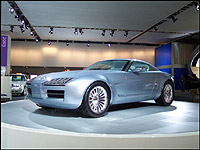 |
| Powered by basically the same V8 engine as the Mustang GT, the Messenger concept not only looks fast but also has the acceleration to back it up. (Photo: Photo: Trevor Hofmann, Canadian Auto Press) |
If any Mercury looks fast and agile it's the Messenger concept. Its speed is derived from a 4.6-liter modular V8 engine, basically the same power unit as found in the Mustang GT, mated to a 6-speed automatic with sequential shift technology.
Considering that it should achieve a much lighter curb weight than the Mustang, due to its absolutely non-production spec monocoque construction incorporating super-formed aluminum panels bonded to a composite / aluminum hybrid 'tub' chassis, it most likely will do a good job of zero to 100 km/h sprints. What should be high torsional rigidity should provide superb ride and handling characteristics too, with Formula 1/Champ Car levels of crashworthiness. What's more, NVH levels should be next to none.
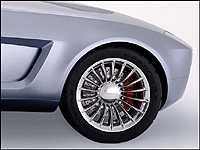 |
| The Messenger is equipped with stunningly beautiful 18-spoke polished alloy wheels - 19-inches up front and 20-inches at the rear. (Photo: Ford Motor Company) |
The Mercury's power assisted variable ratio rack and pinion steering system directs stunningly beautiful 18-spoke polished alloy wheels - 19-inches up front and 20-inches on the rear. The large diameter rims make the 2-seat coupe look smaller than it is while aiding at-the-limit handling. Its Goodyear performance tires are wide at 275/40/R19 on front and 305/40R20 behind, a sizeable contact patch that should translate into excellent grip.
That tenacity should assist braking, already respectable due to high performance Brembo power assisted stoppers with ABS and Electronic Brake force Distribution (EBD). Specifically, four piston calipers at all corners clamp down on 355 mm (14.0 in) vented discs.
The Messenger shows off some pretty sophisticated software and hardware combinations too. The most impressive is its computer active suspension that adjusts the car's ride height, modifies the suspension setup and then integrates 'intelligent' traction control to suit a driver's particular mood, whether sedate or aggressive, all the while making adjustments for road conditions.
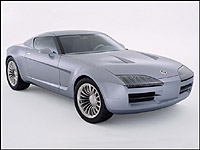 |
| One of the Messenger's most impressive features is its computer active suspension that adjusts the car's ride height, modifies the suspension setup and then integrates 'intelligent' traction control. (Photo: Photo: Ford Motor Company) |
Mercury's new concept has a few additional technologically advanced features as well, including self-leveling high-intensity 'projector' headlamps, quick responding LED brake lights, an automatically monitored and adjusted tire pressure sensing system and a global vehicle theft location system.
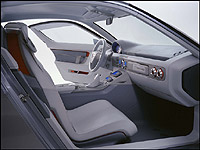 |
| The Messenger is large for a two-seat coupe, and comes with numerous convenience items, including a powerful THX certified digital CD/radio audio system. (Photo: Ford Motor Company) |
The Messenger's convenience items include independent climate control for driver and passenger with pollen filtration, hands free cell phone capability, an automatically dimming interior rear view mirror, powered and heated exterior rear view mirrors, a height and reach adjustable steering column, rain sensing windshield wipers, low-E glass for reduced UV and heat build up, and most importantly a powerful THX certified digital CD/radio audio system with automatic volume control that adjusts with vehicle speed.
Features aside, the new concept is about as large as can be expected of a two-seat coupe. The seats themselves are mounted horizontally to the car's center tunnel and opposing rocker panels, forming an integral part of the aluminum hydroformed monocoque body for stiffening purposes. There is room for stowage in behind with an integrated child seat fitting. By the way, at 340 L (12.0 cu ft) the trunk is fairly large for this class of car.
Leg and headroom appear spacious, and are at 1,084 mm (42.6 in) and 943 mm (38.0 in) respectively, while the use of light gray shades along large uncluttered surfaces makes the Messenger seem even roomier than it is, a treatment that is particularly noticeable across the dash and on the door panels, the latter of which incorporate cutouts mimicking the exterior engine vents just aft of the front wheel cutout - a nice touch. As is currently en vogue polished metal trim is tastefully applied, and thankfully not overdone. Actually the interior designers have done a wonderful job, making it as inviting on the inside as its clean, attractive exterior is to passersby.
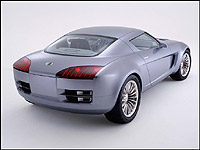 |
| The Messenger is a car that makes you sit up and take notice, but does Mercury have the cachet to attract traditional import buyers? (Photo: Ford Motor Company) |
And what are your thoughts? Is the Messenger a car that would cause you to sit up and take notice, maybe even drag you down to your local Ford dealer and ring up the old platinum card if it were made available? Does the Mercury brand have the cachet necessary to pull buyers out of imports and into a new sports coupe?
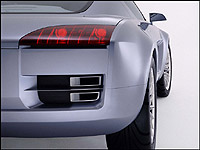 |
| Mercury hasn't announced any plans to build the Messenger. It's only a concept, a crystal ball of things to come. (Photo: Ford Motor Company) |
That's difficult to say. Chrysler, a brand many consider to be the domestic equivalent of Mercury as far as prestige goes, is attempting such a strategy with its new Crossfire coupe. While it's a superb vehicle, easily as good as any import - heck, 39 percent of it is a Mercedes-Benz SLK so it better be good - customers aren't exactly lining up, pushing and shoving to drive one home. Then again if Chrysler has the patience necessary to allow such a small volume car to trickle out of its dealerships, all the while benefiting the rest of the brand with the positive halo effect that comes from having a high quality sports car in the lineup, they'll most likely do well in the long run.
But Mercury hasn't announced any plans to build the Messenger. It's only a concept, a crystal ball of things to come. All I can say to this end is the brand could use an image builder. They need a car that puts them on Joe and Jane Public's radar screen, even if they're only buying a new Monterey minivan.
As for us Canadians, Mercury left our shores as a brand a few years back. Sure a couple of models are still sold here under the Ford blue oval, but despite saying Ford Grand Marquis and Ford Marauder on the web site the cars are still badged Mercury in the flesh. What a confusing marketing mess that is. I'm just glad I'm not on the showroom floor, having to explain it on a daily basis to Canada's perplexed car buyer.
 |
| Something like the Messenger would be just the car needed to bring some notoriety back to the Mercury nameplate. (Photo: Ford Motor Company) |
While I personally would welcome Mercury back with open arms, as I think their new designs are among the more attractive coming out of Detroit at the present time, it's most likely not going to happen all too soon.
But then again Ford Motor is putting more money behind what had almost become a forgotten brand, building it up as a solid middle step between blue oval base models and top-tier Lincolns. Something like the Messenger would be just the car needed to bring some notoriety back to the Mercury nameplate. Here's hoping.
Specifications: